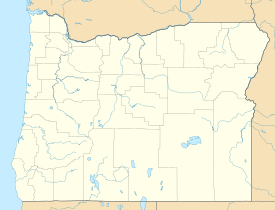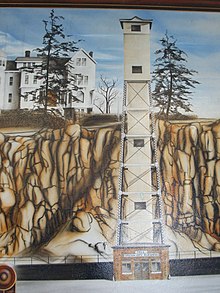Oregon City Municipal Elevator
| Oregon City Municipal Elevator | ||
|---|---|---|
| National Register of Historic Places | ||
| NRHP | ||
|
|
||
| location | 610 Bluff Street Oregon City , Oregon |
|
| Coordinates | 45 ° 21 '24.9 " N , 122 ° 36' 27.7" W | |
| Built | 1954-55 | |
| architect | Gordon E. Trapp | |
| NRHP number | 14000181 | |
| The NRHP added | May 15, 2014 | |
The Oregon City Municipal Elevator is a 40 m high elevator system that connects two districts of Oregon City in the US state of Oregon . The elevator is the only municipal elevator outside a building in the United States and one of only four such facilities in the world. In the upper part of the complex there is a viewing platform, the appearance of which is reminiscent of a flying saucer .
The existing system is the second at this point; it was built in the years 1954–55 and was added to the National Register of Historic Places in 2014.
Geography of Oregon City
The metropolitan area of Oregon City spans great elevation changes. The central business district is wedged between the Willamette River and a basalt cliff and is only a few blocks wide. Another district is located above the 27 m high cliff. Indian paths overcame the difference in altitude and were used by the white settlers after the city was founded in 1829 to connect the two districts. In the mid-1860s, several stairs were built, but better transport links were necessary.
Original plant
In July 1912, a loan was presented to the electorate for approval to raise $ 12,000 to build an elevator, but the proposal was rejected. In December of the same year, the measure was adopted in a second referendum . Delayed by politics, the facility was opened to the public in 1915. This original system was powered by hydropower and the journey took three minutes. It was so popular with the public that most of the stairs were removed. In 1924 the drive was electrified, which reduced the travel time to 30 seconds.
Current elevator system

After 40 years of operation, the citizens of the city voted in a vote in May 1952 about a new building at a construction cost of 175,000 US dollars. The tenders stipulated that the design should be "as simple as possible, without ornamentation". The new structure, designed by Gordon E. Trapp and planned by the engineer Ervin Aksel Sööt, manufactured Otis Elevator and featured push-button operation and automatic doors, and travel time was reduced to 15 seconds. The plant was inaugurated on May 5, 1955 and is still in operation today. In 2004 the engine room was equipped with a digital control.
The elevator system is practically part of 7th Street, because both entrances open on S. 7th Street, which is an important thoroughfare on both levels. The lower entrance is at the intersection of 7th Street ( Oregon Route 43 ) and Railroad Avenue; a short pedestrian underpass runs under the tracks of the Union Pacific Railroad and opens into the elevator building. The upper entrance is accessed from S. High Street, a short distance from the intersection of 7th Street and Singer Hill (this street runs along the side of the cliff and connects 7th Street above with S. 10th Street below). From an observation deck at the top of the hatch, there is a view of Willamette Falls , Oregon City Bridge and Abernethy Bridge .
The elevator system is operated by an elevator operator and is in operation on weekdays from 6:45 a.m. to 7:00 p.m. and on Sundays from 11:00 a.m. to 7:00 p.m. Use of the elevator is free of charge. In 1989, an average of 500 users a day used the elevator; in 2008, the daily number of users was just under 800. in the tourist season the elevator is used by up to 1300 people.
See also
supporting documents
- ^ Mount Hood Territory History, Museums, Historic Sites and Transportation ( English ) Clackamas County Tourism Development Council. Archived from the original on May 18, 2006. Retrieved June 17, 2017.
- ↑ Deanna Hart: Going to the next level ( English ) In: American City and County Magazine . P. 62 June 2008.
- ↑ Rick Bella: Getting a lift out of life (English) . In: The Oregonian , p. B3.
- ↑ Weekly list of actions taken on properties: 5/19/14 through 5/23/14 ( English ) National Park Service . May 30, 2014. Retrieved June 17, 2017.
- ^ Susan Hauser: Oregon City - The town at the end of the Oregon Trail is still a destination for travelers ( English ) VIA, the bimonthly travel magazine of the California State Automobile Association. January / February 2004. Archived from the original on August 24, 2010.
- ↑ Oregon City Municipal Elevator ( English ) End of the Oregon Trail Interpretive Center. Archived from the original on January 6, 2007. Retrieved June 17, 2017.
- ↑ According to the information on a sign at the foot of the lift system, see this photo .
Web links
- Oregon City Municipal Elevator on the Municipal Department of Public Works website



